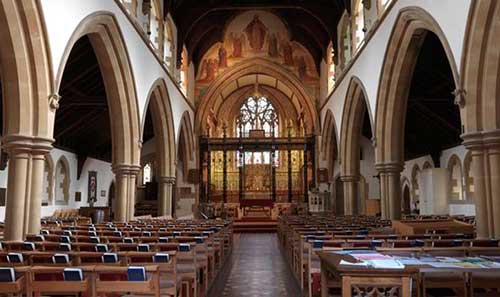
I have just spent some time in Australia. Often, after traveling around parts of New Zealand, I reflect on how we (Anglicans mostly) could do so much better to invite and welcome newcomers and visitors to our Sunday (public) worship. My experience this trip in Australia is, unfortunately, akin to my experience in New Zealand: we can do so, so much better. Especially with our online presence (in this Digital Reality we live in, in the Third Millennium). And also: it just isn’t very difficult.
This post is simply a potpourri of story points. It is anecdotal and not attempting to be exhaustive or statistically analytical. Nor am I dismissive of the many, many great things being done. I have done my best to anonymise my stories to protect the guilty.
People generally search on Google for cafes, restaurants, accommodation, and… churches. The first port of call is often the Google “business profile” (on the top right on a laptop screen, or top of the page on what most people use: a phone). If your church community hasn’t taken control of this Google profile, that is a mortal sin! Churches should be as easy to find as cafes – and information about the church should be as user-friendly as the information about such cafes, restaurants, accommodation. When the bishop asked me to be priest in charge of a parish a couple of years ago, that was one of the first things I did – make sure we controlled the profile and that it was up to date.
Traveling, I have seen people put questions on the profile – and the church hasn’t answered. And they were questions like: “What time are your services?” “What time are your Christmas services?” “What time are your Easter services?” One after another after another – all with no response!
Photos from your community should be more than different views of your building!
One shocker: I found the church website by a Google search, but when I clicked on it, I was told the website was being “rebuilt” with absolutely no other information. So, I went back to the Google search, and found they are on facebook. Clicking on that link I found, yes, it is current, with several new posts that day (I couldn’t see the posts, only the number). BUT – this, for some unknown reason, IS A PRIVATE GROUP!!! I would have to apply to join this private parish Facebook group if I wanted to find out where the church is, and what time its services are…
One tourist mecca (that term is even a faith term!), with tens of thousands of visitors, there was absolutely no Anglican presence. This is in part due to the way Anglicanism is organised: a local (parish) church is financed by the regular pew-sitters. In this case, the fixed population was small. Yes, there could be a lot of tourists, visitors, travellers, holiday-makers who have the time and leisure to reflect on meaning, and to celebrate life, etc. but they won’t be there in our pews next week!!! If we “convert” them, they won’t be in our pews, they will be putting money into another community’s collection plate when they get home enthusiastic about church because of what we offered… If that is the attitude (and I think there are unspoken elements of this that are true) I challenge this thinking.
At one church service, the sound system had a complex echo that destroyed the ability to make any sense of what was said. Luckily, all the service was printed in the pew sheet provided. But the sermon (and notices) were completely lost on me.
One (open – yay!!!) church building had different information on the notice board outside to what was written on notice boards inside. And both outside and inside notice boards were different to what actually happened there.
If currently your community has stopped or paused using a certain social media platform, please (pretty please with a cherry on top!) have the last (or pinned) post clearly state this – and also where current information can be found.
One of the best web presences I encountered was a simple WordPress site with service dates, times, and what sort of service it is – in plain language. There was a simple mission statement, street address, map, public transport information, contact information, phone numbers, and emails. There were photos – lots with people. And a history.
It wouldn’t hurt, but I’m not going to emphasise dropping pamphlets in every accommodation – that can sit attractively and informatively alongside the other brochures about local activities.
I am (sort of) heartened that it is not just the church that makes things difficult for visitors and newcomers. “Secular” experiences of making-it-difficult-for-visitors-and-newcomers become parables (for me) of what it must be like for newcomers and visitors to church.
Example/parable 1: arriving at an accommodation complex, the person on Reception said all the correct things and handed over a map of the complex outlining where the room was. The verbal information was said without real interest or emotion – these were the same words that clearly had been said dozens and dozens of times. I came away from the desk with maybe one point – the rest had all flowed over me. As for the map, it might have been clear to the person who produced it, but it was not designed with a new-user in mind (surely the point of it!). It took time for me to realise that vertical floors were represented horizontally, and what looked like corridors or gaps between buildings were actually streets!
Example/parable 2: I wanted to travel by rail from the capital of State A to the capital of State B and went to the railway station of A to be sure of the platform and to purchase the ticket. Buying the ticket was impossible. This was a State B train simply borrowing the platform in State A. Finally, after some “continuing conversation” on my part, I was reluctantly given a phone number on a 2x3cm piece of paper – I could ring the State B railway and see if I could book something that way.
To conclude: the capital of State B has several million people living there. An inner-city Roman Catholic Church has daily exposition, and as I walked past day by day, there were always dozens of people in there praying. Daily Mass attendance looked to have a congregation of about 60ish. This is a sign of people’s love of spirituality, people’s yearning for the contemplative, prayerful dimension. Then I walked past the Anglican cathedral. It was locked. All day. With a notice stating which days of the week it was open, and what limited hours on those days.
Do follow:
The Liturgy Facebook Page
The Liturgy Twitter Profile
The Liturgy Instagram
and/or sign up to a not-too-often email



Speaking of welcoming/excluding … when I go to England, it always shocks me that the musical notes are not printed in the hymnals. There are literally hundreds of hymn LYRICS, but no musical notation. A few introductory bars on the organ just are NOT enough. My British friends say that “no one knows how to read music” but at least in North America, all mainline groups print the music (and many print it directly in the weekly bulletin, so there’s no need to juggle books).